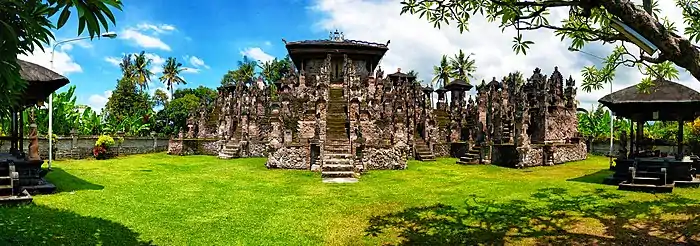Buleleng Regency
Buleleng is a regency (kabupaten) of Bali, Indonesia. It has an area of 1,365.88 km2 and population of 624,125 at the 2010 Census;[2] the latest official estimate (as at mid 2017) is 653,600.[3] Its regency seat is at Singaraja.
Buleleng Regency
Kabupaten Bulelengᬓᬩᬸᬧᬢᬾᬦ᭄ᬩᬸᬮᭂᬮᭂᬂ | |
|---|---|
 Seal | |
| Motto(s): Singa Ambaraja | |
 Location of Buleleng Regency in Bali | |
| Country | |
| Province | |
| Capital | Singaraja |
| Government | |
| • Regent | Putu Agus Suradnyana |
| Area | |
| • Total | 527.37 sq mi (1,365.88 km2) |
| Population (mid 2017)[1] | |
| • Total | 653,600 |
| • Density | 1,200/sq mi (480/km2) |
| Time zone | UTC+8 (WITA) |
| Area code(s) | +62 362 |
| Website | bulelengkab.go.id |




Buleleng was founded as a kingdom by Gusti Panji Sakti, who ruled c. 1660-c. 1700. He is commemorated as a heroic ancestor-figure who expanded the power of Buleleng to Blambangan on East Java.[4] The kingdom was weakened during his successors, and fell under the suzerainty of the neighbouring Karangasem kingdom in the second half of the 18th century. It was headed by an autonomous branch of the Karangasem Dynasty in 1806-1849.
The Dutch attacked Buleleng in 1846, 1848 and 1849, and defeated it on the last occasion.[5] Buleleng was incorporated in the Dutch colonial system and lost its autonomy in 1882. In 1929 a descendant of Gusti Panji Sakti, the renowned scholar Gusti Putu Jelantik, was appointed regent by the Dutch. He died in 1944, during the Japanese occupation of Indonesia. His son was a well-known novelist, Anak Agung Nyoman Panji Tisna. In 1947, Anak Agung Pandji Tisna surrendered the throne to his younger brother, Anak Agung Ngurah Ketut Djelantik, known as Meester Djelantik, until 1950. In 1949-50 Buleleng, like the rest of Bali, was incorporated in the unitary republic of Indonesia.
Administrative districts
The regency is divided into nine districts (kecamatan), tabulated below with their areas and population totals from the 2010 Census[6] and the official estimates for mid 2017.[7] The table also includes the number of administrative villages (rural desa and urban kelurahan) in each district, and its postal codes.
| Name | Area in km2 | Population Census 2010[8] | Population Estimate mid 2017[9] | Number of villages | Post codes |
|---|---|---|---|---|---|
| Gerokgak (a) | 356.57 | 78,825 | 83,890 | 14 | 81155 |
| Seririt | 111.78 | 69,572 | 72,570 | 21 | 81153 |
| Busungbiu | 196.62 | 39,719 | 40,820 | 15 | 81154 |
| Banjar | 172.60 | 68,960 | 72,260 | 17 | 81152 |
| Sukasada | 172.93 | 72,050 | 77,090 | 15 | 81161 |
| Buleleng | 46.94 | 128,899 | 136,790 | 29 | 81111 -81119 |
| Sawan | 92.52 | 58,578 | 60,480 | 14 | 81171 |
| Kubutambahan | 118.24 | 53,765 | 55,550 | 13 | 81172 |
| Tejakula | 97.68 | 53,757 | 54,150 | 10 | 81173 |
| Totals | 1,365.88 | 624,125 | 653,600 | 148 |
Note: (a) included offshore Menjangan Island.
Airports
Lt.Col. Wisnu Airfield is located in the Sumberkima village.
Research of a new airport was completed in 2017, due to the congestion of Ngurah Rai International Airport. The new two-runway airport will be built in the east part of Buleleng Regency, and will be connected by railway to the existing airport.[10] Kubutambahan, 15 kilometers east of Singaraja, was decided to be the new airport site over two other candidates, Sangsit and Gerokgak, after taking into account geographical conditions, wind speed, wind direction, and other factors.[11]
Pearl producers
Many big pearl producers have developed a 130.9 hectares in Gerokgak village as an area for pearl breeding and world-class pearl productions. It will enlarge to 250 hectares swath of water stretching from Gerokgak to Kubutambahan.[12]
Gallery
 Two warriors in Buleleng, 1865
Two warriors in Buleleng, 1865 Balinese and Papuan slaves of the Rajah of Buleleng, 1865
Balinese and Papuan slaves of the Rajah of Buleleng, 1865

References
- Badan Pusat Statistik, Jakarta, 2020.
- Biro Pusat Statistik, Jakarta, 2011.
- Badan Pusat Statistik, Jakarta, 2020.
- H.J. de Graaf, 'Goesti Pandji Sakti, vorst van Boeleleng', Tijdschrift voor Indische Taal-, Land- en Volkenkunde 83:1 1949.
- Pringle, pp. 96-100
- Biro Pusat Statistik, Jakarta, 2011.
- Badan Pusat Statistik, Jakarta, 2020.
- Biro Pusat Statistik, Jakarta, 2011.
- Badan Pusat Statistik, Jakarta, 2020.
- "Expanded Bali airport to be at full capacity by 2017". Archived from the original on 2012-08-11. Retrieved June 23, 2012.
- "Kubutambahan to become airport site". July 31, 2012. Archived from the original on 2012-08-04. Retrieved 2012-07-31.
- http://www.thejakartapost.com/news/2011/07/13/north-bali-coast-boasts-major-pearl-producers.html
External links
- Pringle, Robert (2004). Bali: Indonesia's Hindu Realm; A short history of. Short History of Asia Series. Allen & Unwin. ISBN 1-86508-863-3.
 North Bali travel guide from Wikivoyage
North Bali travel guide from Wikivoyage